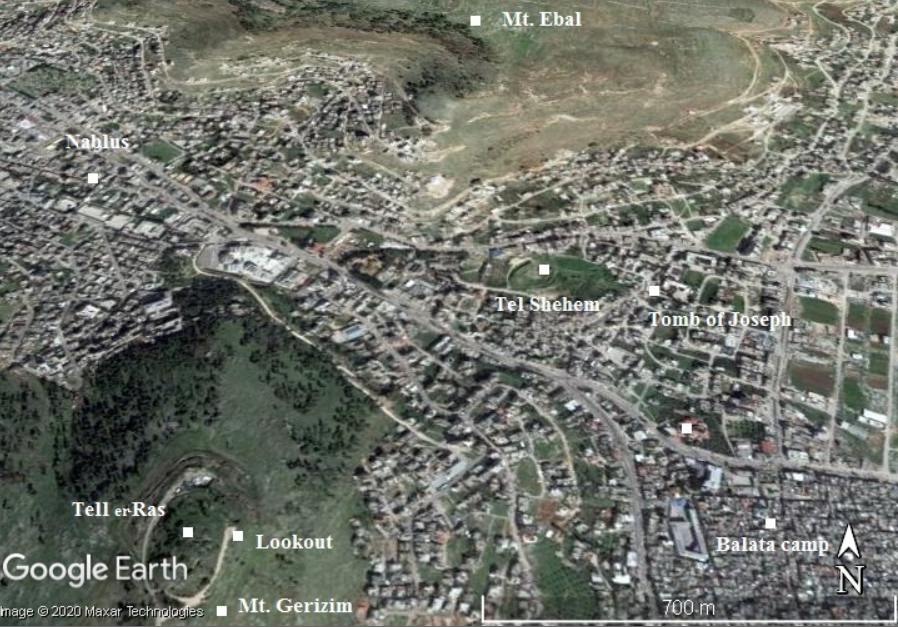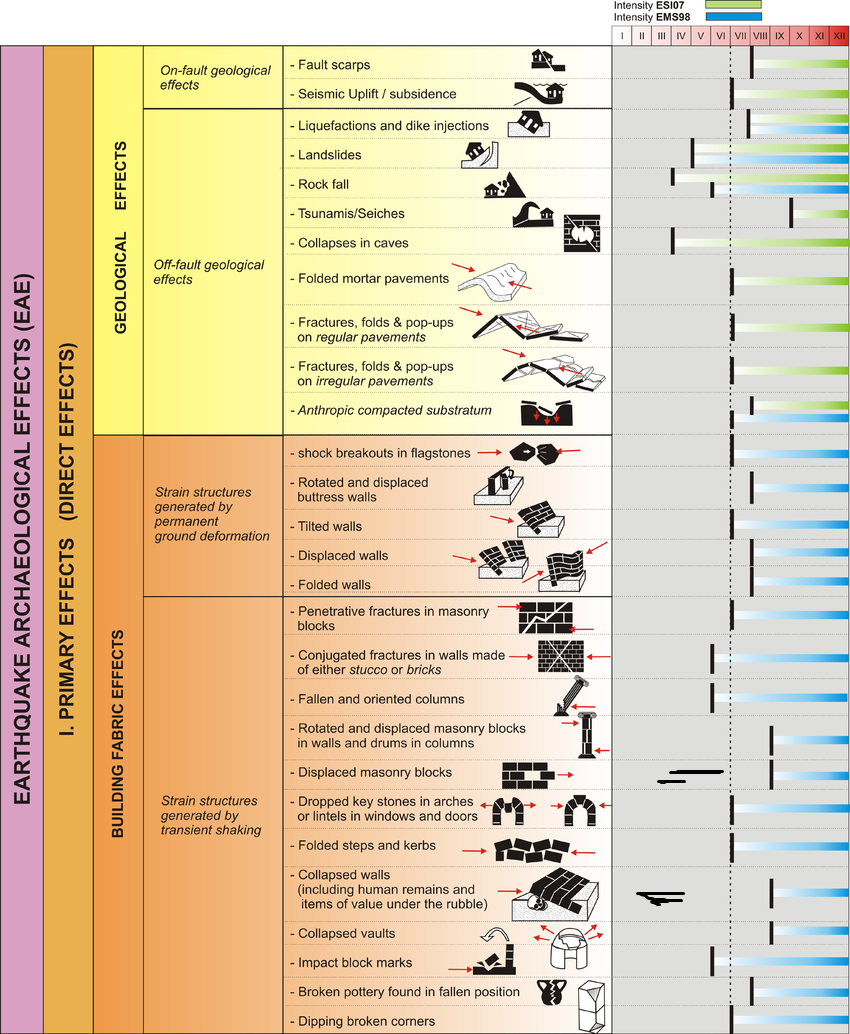Tell er-Ras
 Mound of Tell er-Ras
Mound of Tell er-RasClick on image to open a slightly higher res image in a new tab
Used with permission from BibleWalks.com
| Transliterated Name | Source | Name |
|---|---|---|
| Tell er-Ras | Arabic |
Tell er-Ras, located on a north trending ridge off the peak of Mount Gerizim overlooks Tell Balata/Shechem and contains the remains of a Temple to Zeus.
- Fig. 7 - Location Map from
Bull and Campbell (1968)

 Figure 7
Figure 7
Map of the Nablus region showing the line of the stairway from the valley to the temple site.
JW: Also showing the location of Ancient Shechem center right
Bull and Campbell (1968) - Annotated Satellite View of
Tell er-Ras and environs from biblewalks.com

 Annotated Satellite View of Tell er-Ras and environs
Annotated Satellite View of Tell er-Ras and environs
Used with permission from BibleWalks.com - Tell er-Ras in Google Earth
- Tell er-Ras on govmap.gov.il
- Fig. 3 Plan of structures on
Tell er-Ras from Bull and Campbell (1968)

 Figure 3
Figure 3
Outline plan of the structures on Tell er-Ras
Bull and Campbell (1968) - Fig. 12 Plan of Building A
(Hadrianic temple) from Bull and Campbell (1968)

 Figure 12
Figure 12
Plan of Building A, the Hadrianic temple on Tell er-Ras
Bull and Campbell (1968)
- Fig. 3 Plan of structures on
Tell er-Ras from Bull and Campbell (1968)

 Figure 3
Figure 3
Outline plan of the structures on Tell er-Ras
Bull and Campbell (1968) - Fig. 12 Plan of Building A
(Hadrianic temple) from Bull and Campbell (1968)

 Figure 12
Figure 12
Plan of Building A, the Hadrianic temple on Tell er-Ras
Bull and Campbell (1968)
- Fig. 8 Section through Cistern II
from Bull and Campbell (1968)

 Figure 8
Figure 8
Section through Cistern II, looking west
Bull and Campbell (1968)
- Fig. 8 Section through Cistern II
from Bull and Campbell (1968)

 Figure 8
Figure 8
Section through Cistern II, looking west
Bull and Campbell (1968)
- Illustration of the sanctuary
of Zeus on Tell er-Ras from biblewalks.com

 Illustration of the sanctuary of Zeus on Tell er-Ras
Illustration of the sanctuary of Zeus on Tell er-Ras
Used with permission from BibleWalks.com
Bull and Campbell (1968:4-6) reported on excavations at Tell er-Ras,
which is located on a north trending ridge off the peak of
Mount Gerizim and overlooks Tell Balata (ancient Shechem). There
they encountered the remains of a Temple Complex dedicated to Zeus which they suggested was built during
Emperor Hadrian's visit to Palestine around 130 CE.
Adjacent to Wall 12,000 which surrounded Buildings A and B (presumed to be part of the Zeus Temple Complex),
Bull and Campbell (1968:15-17)
encountered six cisterns. They excavated three.
At the bottom of Cistern II, a 0.15 meter thick layer of black silt was overlain by a 0.2 meter thick layer of compact fine grey silt
.
These two silty layers, containing a large quantity of pottery, glass fragments, coins, and other artifacts
, were overlain by an apparent destruction layer -
1.10 m of loose grey earth containing architectural fragments, vaulting, and building stones
.
43 dateable coins were recovered from the two silty layers in Cistern II ranging in age from
Severus Alexander (222-235) to
Julian II (360-363) - providing a terminus post quem of
360 CE for the destruction layer. Cisterns I and VI exhibited similar stratigraphy to Cistern II.
Bull and Campbell (1968:16) noted that the cisterns
abutted and post dated Wall 12,000 which had been part of the Zeus Temple Complex.
Bull and Campbell (1968:6) also reported that
late and often confusing Samaritan records
indicate that the Temple to Zeus was in ruins by the time of
Julian II (360-363) indicating that the cisterns
likely fell into disuse and began to silt up prior to 363 CE.
| Effect | Location | Figure | Comments |
|---|---|---|---|
| Collapsed Walls and architecture | Cistern II
 Figure 3
Figure 3Outline plan of the structures on Tell er-Ras Bull and Campbell (1968) 
 Figure 8
Figure 8Section through Cistern II, looking west Bull and Campbell (1968) |
|
- Earthquake Archeological Effects chart
of Rodríguez-Pascua et al (2013: 221-224)

 Earthquake Archeological Effects (EAE)
Earthquake Archeological Effects (EAE)
Rodríguez-Pascua et al (2013: 221-224)
| Effect | Location | Figure | Comments | Intensity |
|---|---|---|---|---|
| Collapsed Walls and architecture | Cistern II
 Figure 3
Figure 3Outline plan of the structures on Tell er-Ras Bull and Campbell (1968) 
 Figure 8
Figure 8Section through Cistern II, looking west Bull and Campbell (1968) |
|
VIII + |
E. Sellin, Anzeiger der Kaiserliche Akademie der Wissenschqften in Wien, Philologisch-historische Klasse 51 (1914), 35-40, 204-207; id., ZDPV 49
(1926), 229-236, 304-320; 50 (1927), 205-211, 265-274; 51 (1928), 119-123;
E. Sellin and H. Steckeweh, ibid. 64 (1941), 1-20; G. Welter, Archaeologischer Anzeiger (1932), 289-314.
D.P. Cole, Shechem I: The Middle Bronze IIB Pottery, Winona Lake, Ind. 1984 - can be borrowed with a free account from archive.org
E. F. Campbell, Shechem II: Portrait of a Hill Country Vale, Atlanta 1991. - can be borrowed with a free account from archive.org
E. Sellin, Anzeiger der Kaiserliche Akademie der Wissenschqften in Wien, Philologisch-historische Klasse 51 (1914), 35-40, 204-207; id., ZDPV 49
(1926), 229-236, 304-320; 50 (1927), 205-211, 265-274; 51 (1928), 119-123;
E. Sellin and H. Steckeweh, ibid. 64 (1941), 1-20; G. Welter, Archaeologischer Anzeiger (1932), 289-314.
G. E. Wright, Shechem: The Biography of a Biblical City, New York 1965
D.P. Cole, Shechem I: The Middle Bronze lIB Pottery, Winona Lake, Ind. 1984
E. F. Campbell, Shechem II: Portrait of a Hill Country Vale, Atlanta 1991.
G. E. Wright et al., BASOR 144 (1956), 9-26; 148 (1957), 11-28
L. E. Toombs and G. E. Wright, ibid. 161 (1961), 11-54; 169 (1963), 1-60
L. E. Toombs, ADAJ 17 (1972), 99-110;
R. J. Bull (et al.),BASOR ISO (1965), 7-41; id. (and E. F. Campbell), ibid. 190(1968), 2-41
E. F. Campbell etal., ibid. 204 (1971), 2-17
J.D. Seger, ibid. 205 (1972), 20-35
G. R. H. Wright, ZDPV89 (1973), 188-196
W. G. Dever, BASOR 216 (1974), 31-52
R. Boling, BASOR Supplementary Studies 21 (1975), 25-85.
Reports of Israeli excavations
A. Zertal, TA 13-14 (1987), 105-165 [el-Burnat].
F. W. Freiherr von Bissing, Mededelingen der Koniklijke Akademie van Wetenschappen, Amsterdam, Afd. Letterkunde 62/B (1926), 1-24
H. W. Muller, Der Waffenfund von Balata-Sichem und die Sichelschwerter, Munich !987 [weapon hoard]
F. M. T. Bohl, ZDPV 49 (1926) 320-327
W. F. Albright, BASOR 86 (1942), 28-31 [cuneiform tablets]
F. M. Cross, Jr., ibid. 167 (1962),14-15
A. Zeron, TA 6(1979), 156-157[/mbn seal]
S. H. Horn,JNES2i (1962), 1-14;25 (1966) 48-56; 32(1973), 281-289 [scarabs]
0. R. Sellers, BA 25 (1962), 87-96 [coins]
G. E. Wright, BASOR 167 (1962), 5-13 [seals]
G. R. H. Wright, PEQ 97 (1965), 66-84; 101 (1969), 34-36 [fluted columns]
V. Kerkhof, BASOR 184 (1966), 20-21 [inscribed stone weight]
M. H. Wieneke, JNES 35 (1976), 127-130 [clay sealings]
S. Geva, ZDPV 96 (1980), 41-47 [tridacna shell]
P. W. Lapp, BASOR 172 (1963), 22-35 [stamped jar handles]
id., Palestinian Ceramic Chronology, 200 BC-AD 70, New Haven 1961,41-49 and passim
N. L. Lapp, BASOR 175 (1964), 14-26 [Hellenistic pottery]
P. W. Lapp, Archiiologie und A/tes Testament (K. Galling Fest.), Tiibingen 1970, 179-197
N. L. Lapp, BASOR 257 (1985), 19-43 [Persian pottery]
J. S. Holladay, Magnolia Dei: The Mighty Acts of God (G. E. Wright Fest., eds. F. M. Cross, Jr., etal.), Garden City, N.Y. 1976, 253-293 [Iron II pottery]
R. S. Boraas, The Archaeology of Jordan and Other Studies (S. H. Horn Fest.), Berrien Springs, Mich. 1986, 249-263 [Iron I pottery]
D. P. Cole, Shechem I: The Middle Bronze IIB Pottery, Winona Lake, Ind. 1984
G. R. H. Wright, Opuscula Atheniensia 7 (1967), 47-75 [Cypriot and Aegean pottery]
S. H. Horn, Jaarbericht ex Oriente Lux 20 (1968), 71-90 [1913-1914 objects]
S. H. Horn and L. G. Moulds, AUSS 7 (1969), 2-46 [1913-1914 pottery]
V. Kerkhof, Oudheidkundige Mededelingen uit het Rijksmuseum van Oudheden te Leiden 50 (1969), 38-109 [artifacts from the Austro-German expeditions].
F. M. T. Bohl, De Opgraving van Sichem, Zeist, Netherlands 1927
E. Sellin, ZAW 50(1932), 303-308
R. J. Bull, BA 23 (1960), 110-119
R. J. Bull and G. E. Wright, Harvard Theological Review 58 (1965), 234-237
E. F. Campbell and J. F. Ross, BA 26 (1963), 2-27
E. F. Campbell, Magnolia Dei: The Mighty Acts of God (G. E. Wright Fest., eds. F. M. Cross, Jr., etal.), Garden City, N.Y. 1976,39-54
id., The Word of the Lord Shall Go Forth (D. N. Freedman Fest.), Winona Lake, Ind. !983, 263-271
id., The Answers Lie Below (L. E. Toombs Fest.), Lanham, Md. 1984 67-76
S. H. Horn, Jaarbericht Ex Oriente Lux 18 (1965), 284-306
G. E. Wright, Archaeology and Old Testament Study, London 1967, 355-370
J. F. Ross and L. E. Toombs, Archaeological Studies in the Holy Land, New York 1967, 119-127
G. R. H. Wright, ZDPV83 (1967), 199-202
id., ZAW80 (1968), 1-35; 82 (1970), 275-278; 87 (1975) 56-64
id., PEQ 103 (1971), 17-32
id., Zeitschriftfiir Assyriologie 74 (1984), 267-289
id., ZDPV 101 (1986),1-8
J.D. Seger, Levant 6 (1974), 117-130
id., EI 12 (1975), 34*-45*
K. Jaros, Sichem, Gottingen 1976
K. Jaros and B. Deckert, Studien ziir Sichem-Area, Giittingen 1977
L. E. Toombs, ASOR Symposia, 69-83
id., Put Your Future in Ruins (R. J. Bull Fest.), Briston, Ind. 1985, 42-60
M.D. Fowler, PEQ 115 (1983), 49-53
R. G. Boling and E. F. Campbell, Archaeology and Biblical Interpretation (D. Glenn Rose
Fest.), Atlanta 1986, 259-272
D. Dorsey BASOR 268 (1987), 57-70.

